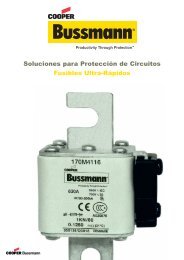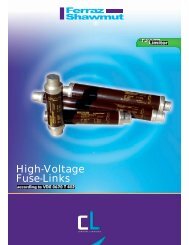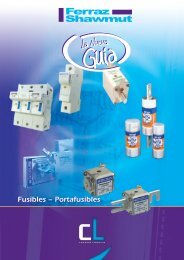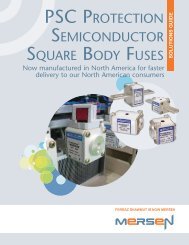Bussmann
You also want an ePaper? Increase the reach of your titles
YUMPU automatically turns print PDFs into web optimized ePapers that Google loves.
Fuse Technology<br />
<strong>Bussmann</strong> ®<br />
Fuse Time-Current Curves<br />
When a low level overcurrent occurs, a long interval of time will<br />
be required for a fuse to open (melt) and clear the fault. On the<br />
other hand, if the overcurrent is large, the fuse will open very<br />
quickly. The opening time is a function of the magnitude of the<br />
level of overcurrent. Overcurrent levels and the corresponding<br />
intervals of opening times are logarithmically plotted in graph<br />
form as shown to the right. Levels of overcurrent are scaled on<br />
the horizontal axis; time intervals on the vertical axis. The curve is<br />
thus called a “time-current” curve.<br />
This particular plot reflects the characteristics of a 200A, 250V,<br />
LOW-PEAK YELLOW dual-element fuse. Note that at the 1,000A<br />
overload level, the time interval which is required for the fuse to<br />
open is 10 seconds. Yet, at approximately the 2,200A overcurrent<br />
level, the opening (melt) time of a fuse is only 0.01 seconds.<br />
It is apparent that the time intervals become shorter as the overcurrent<br />
levels become larger. This relationship is termed an<br />
inverse time-to-current characteristic. Time-current curves are<br />
published or are available on most commonly used fuses showing<br />
“minimum melt,” “average melt” and/or “total clear” characteristics.<br />
Although upstream and downstream fuses are easily<br />
coordinated by adhering to simple ampere ratios, these time-current<br />
curves permit close or critical analysis of coordination.<br />
Better Motor Protection in Elevated Ambients<br />
The derating of dual-element fuses based on increased ambient<br />
temperatures closely parallels the derating curve of motors in elevated<br />
ambient. This unique feature allows for optimum protection<br />
of motors, even in high temperatures.<br />
Affect of ambient temperature on operating characteristics of FUSETRON<br />
150<br />
TIME IN SECONDS<br />
400<br />
300<br />
200<br />
100<br />
80<br />
60<br />
40<br />
30<br />
20<br />
10<br />
8<br />
6<br />
4<br />
3<br />
2<br />
1<br />
.8<br />
.6<br />
.4<br />
.3<br />
.2<br />
LOW-PEAK YELLOW<br />
LPN-RK200 SP (RK1)<br />
140<br />
PERCENT OF RATING OR<br />
OPENING TIME<br />
130<br />
120<br />
110<br />
100<br />
90<br />
80<br />
70<br />
60<br />
Affect on<br />
Opening Time<br />
Affect on Carrying<br />
Capacity Rating<br />
.1<br />
.08<br />
.06<br />
.04<br />
.03<br />
.02<br />
50<br />
40<br />
.01<br />
30<br />
–76°F<br />
(–60°C)<br />
–40°F<br />
(–40°C)<br />
–4°F<br />
(–20°C)<br />
–32°F<br />
(0°C)<br />
68°F<br />
(20°C)<br />
104°F<br />
(40°C)<br />
140°F<br />
(60°C)<br />
176°F<br />
(80°C)<br />
212°F<br />
(100°C)<br />
100<br />
200<br />
300<br />
400<br />
600<br />
800<br />
1,000<br />
2,000<br />
3,000<br />
4,000<br />
6,000<br />
8,000<br />
10,000<br />
AMBIENT<br />
CURRENT IN AMPERES<br />
and LOW-PEAK YELLOW Dual-Element Fuses.<br />
214






